Facilitation in the metaverse involves guiding immersive virtual reality workshops that blend technology with skilled management. You’ll want to focus on creating safe, ethical environments that respect privacy and foster trust. Features like customizable avatars and spatial audio make interactions feel real and engaging. As a facilitator, your role is to manage participation, keep activities dynamic, and handle technical issues. If you want to discover how to design impactful VR sessions and overcome common challenges, there’s more to explore.
Key Takeaways
- Facilitation in the metaverse involves managing interactions, ensuring participant engagement, and fostering collaboration in immersive virtual environments.
- Effective VR workshop facilitation requires understanding ethics, immersive storytelling, and technical features like avatars and spatial audio.
- Facilitators set clear expectations, promote inclusivity, and adapt activities to maintain participant focus and comfort.
- Designing interactive sessions with storytelling, avatar customization, and collaborative tasks enhances engagement and learning.
- Overcoming challenges involves ensuring reliable technology, fostering connection, and securing interactions with fraud prevention tools.
Understanding the Foundations of VR Facilitation
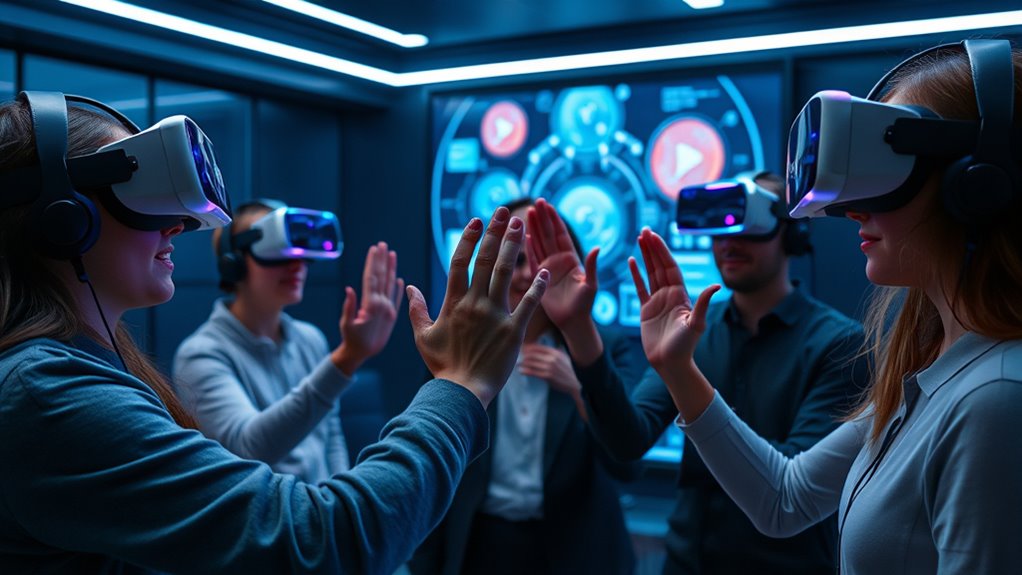
Have you ever wondered what makes virtual reality (VR) facilitation effective? It all starts with understanding virtual reality ethics and immersive storytelling. Ethical considerations guarantee that you create a safe, respectful environment where participants feel comfortable, fostering trust and engagement. You need to be mindful of privacy, consent, and psychological impact, making sure no one feels overwhelmed or exploited. Meanwhile, immersive storytelling helps you craft compelling narratives that captivate your audience, making learning or collaboration meaningful. By blending these core elements, you guide participants through engaging experiences that feel real and impactful. Successful VR facilitation hinges on balancing ethical responsibility with creative storytelling, enabling you to release the full potential of virtual environments while maintaining participant well-being. Additionally, staying aware of emerging AI security vulnerabilities ensures that facilitators can implement safety measures to protect participants from potential risks in virtual spaces.
Key Features of Virtual Reality Workshop Environments
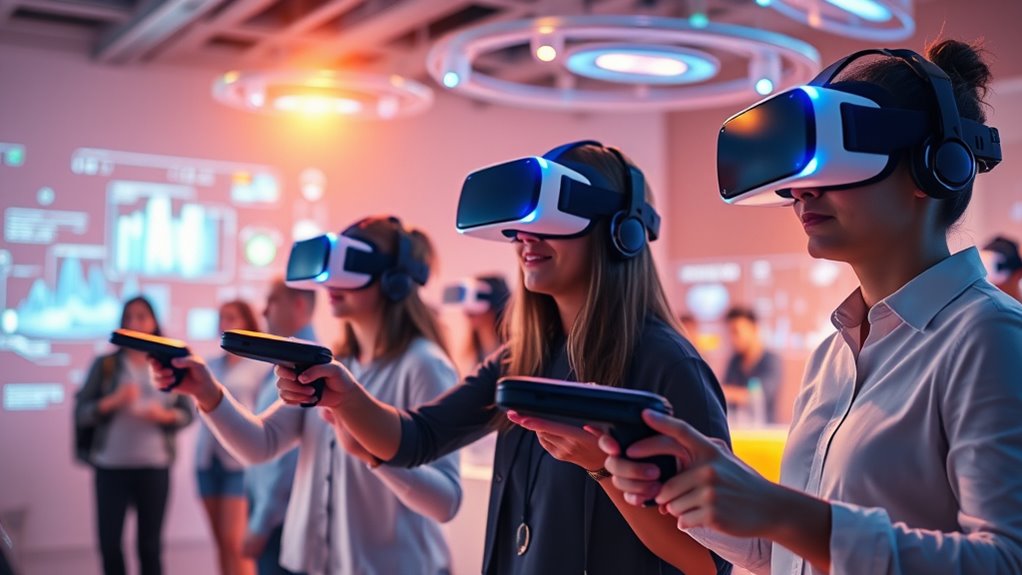
Creating effective virtual reality workshops requires designing environments that are both engaging and functional. One key feature is avatar customization, allowing you to personalize your digital presence, which fosters a sense of identity and comfort. This helps participants feel more connected and engaged during activities. Spatial audio is another essential component, providing realistic sound that adjusts based on your position and orientation. It creates an immersive atmosphere, making conversations and interactions feel natural. These features work together to enhance communication, collaboration, and immersion within the virtual space. A well-designed environment with customizable avatars and spatial audio ensures your workshop is interactive, lively, and conducive to active participation. Prioritizing these features helps you create a seamless and engaging experience for every attendee. Incorporating elements like environment design inspired by real-world spaces further enhances realism and comfort, making the virtual experience more effective and enjoyable.
Roles and Responsibilities of Facilitators in the Metaverse
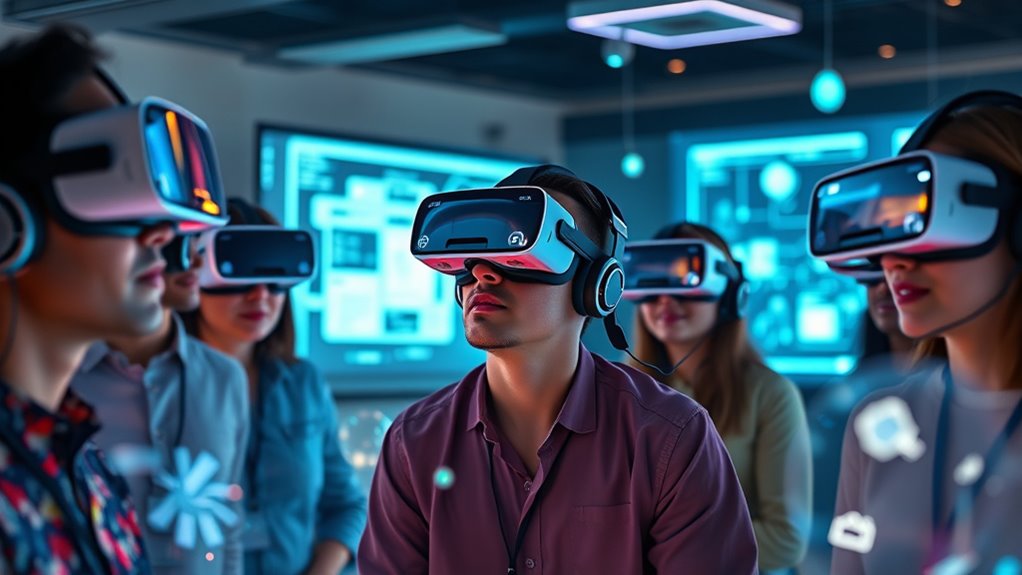
As facilitators navigate the metaverse, they play a crucial role in guiding interactions, maintaining engagement, and guaranteeing that objectives are met. You’re responsible for managing avatar interactions, making sure participants feel comfortable and involved. Effective facilitator training helps you understand how to read virtual cues and address technical issues swiftly. You’ll set clear expectations, foster an inclusive environment, and keep the session on track. Your role also involves monitoring engagement levels and adjusting activities to sustain participation. By actively facilitating discussions and ensuring smooth avatar interactions, you create a dynamic space where participants can collaborate effectively. Ultimately, your responsibilities ensure the virtual environment supports learning, connection, and productivity. Incorporating space and organization principles from home improvement can help create a more structured and efficient virtual setting.
Designing Engaging and Interactive VR Sessions
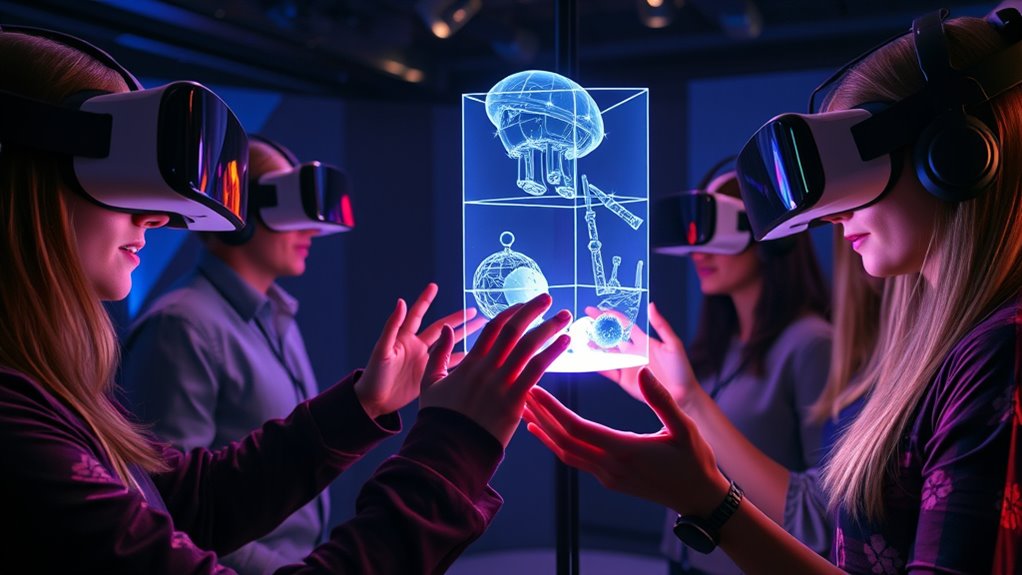
Designing engaging and interactive VR sessions requires you to craft experiences that captivate participants and promote active involvement. Use immersive storytelling to create compelling narratives that draw participants into the virtual environment, making them feel part of a larger story. Integrate avatar customization options so participants can personalize their digital personas, increasing their connection and investment in the session. Incorporate interactive elements like quizzes, polls, or collaborative tasks that encourage participants to actively engage rather than passively observe. Keep the environment dynamic and varied, shifting scenarios or activities to maintain interest. By combining immersive storytelling with avatar customization, you foster a sense of presence and ownership, making your VR sessions more memorable and effective at promoting participation. Additionally, understanding the importance of nutrient retention can help in designing experiences that maximize the value and health benefits of raw food concepts within virtual environments.
Overcoming Challenges and Ensuring Effective Virtual Collaboration
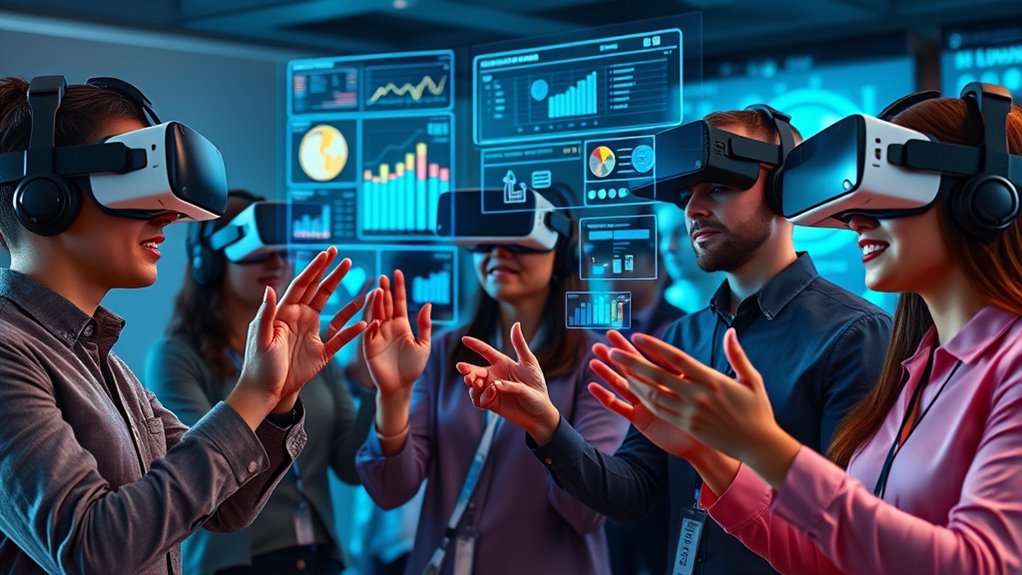
While virtual collaboration in the metaverse offers exciting opportunities, it also presents unique challenges that can hinder effective teamwork. One key issue is ensuring all participants feel connected and engaged, despite physical separation. Avatar customization helps foster a sense of identity and presence, but if avatars aren’t expressive or personalized enough, it can limit communication. Additionally, technical glitches like lag or poor audio can disrupt flow and reduce productivity. To overcome these obstacles, you should prioritize reliable technology and encourage participants to customize avatars thoughtfully, making interactions more natural. Facilitating genuine networking opportunities also boosts team cohesion, helping members build trust and rapport. Incorporating effective fraud prevention tools can also enhance security during virtual interactions, safeguarding sensitive data and maintaining trust among participants. By actively addressing these challenges, you can create a seamless, collaborative environment that maximizes the potential of virtual teamwork.
Frequently Asked Questions
How Do VR Facilitators Handle Technical Issues During Workshops?
When facing technical issues during VR workshops, you quickly perform troubleshooting to identify problems. You guarantee equipment maintenance is up-to-date, which helps prevent glitches. If issues arise, you stay calm and guide participants through simple steps to resolve problems, like reconnecting devices or adjusting settings. You also keep backup plans ready, such as alternative activities, so the workshop continues smoothly without major disruptions.
What Are Best Practices for Participant Engagement in VR Environments?
You might think engaging participants in VR is straightforward, but it’s actually a challenge. To boost avatars interaction and keep immersion high, you should incorporate immersive storytelling techniques that captivate attention. Encourage active participation through gamified activities and real-time feedback. Use clear instructions and foster a welcoming environment. Remember, in VR, your goal is to turn virtual avatars into lively, engaged participants, making the experience memorable and meaningful.
How Is Participant Privacy Protected in the Metaverse?
You protect participant privacy in the metaverse by implementing strong data privacy measures, ensuring personal information is securely stored and only accessible to authorized individuals. You also use anonymity safeguards like pseudonyms or avatar customization to maintain participant identity confidentiality. By clearly communicating privacy policies and obtaining informed consent, you build trust and create a safe environment where participants feel comfortable engaging without fear of data breaches or unwanted exposure.
What Training Is Needed for Effective VR Facilitation?
Imagine leading a virtual facilitation session in the metaverse; you’d need immersive training to succeed. You should learn virtual environment navigation, engagement strategies, and tech troubleshooting. For example, a facilitator who completed specialized VR facilitation courses can better manage participant interactions and technical issues. Effective virtual facilitation requires continuous learning of platform features and immersive training to create impactful, seamless experiences. This prepares you for dynamic, engaging VR workshops.
How Do VR Workshops Compare Cost-Wise to Traditional Sessions?
When comparing VR workshops to traditional sessions, you’ll find the cost comparison varies. VR often requires higher initial investments in equipment and software, but reduces expenses related to venue, travel, and printed materials. An expense analysis shows that over time, VR can become more cost-effective, especially for large groups or remote participants. You’re likely to see savings in logistics, making VR workshops an attractive option despite the upfront costs.
Conclusion
As you facilitate in the metaverse, remember that engaging virtual environments boost collaboration—studies show 80% of participants feel more connected during VR sessions. Embrace the immersive potential to create interactive, dynamic workshops that foster creativity and teamwork. With thoughtful design and clear roles, you’ll overcome challenges and guarantee effective virtual collaboration. The future of facilitation lies in mastering these digital spaces—so plunge in confidently and make your virtual workshops impactful.









